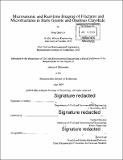Microseismic and real-time imaging of fractures and microfractures in barre granite and opalinus clayshale
Author(s)
Li, Qiuyi Bing.
Download1128185635-MIT.pdf (90.64Mb)
Other Contributors
Massachusetts Institute of Technology. Department of Civil and Environmental Engineering.
Advisor
Herbert Einstein.
Terms of use
Metadata
Show full item recordAbstract
The goal of the work is to better understand field microseismicity through laboratory experiments. Currently, industry practice consists of detecting activity using monitoring stations located around the volume of interest, and subsequently using the data to infer characteristics such as location, magnitude and mechanism of the corresponding microseismic sources. With this approach it is difficult, given the generally great depths of the microseismic activity, to verify characteristics such as the extent, orientation and mechanism of the fracturing activity. Our goal in the laboratory is to address this knowledge gap by imaging the initiation and propagation of hydraulic fractures in real time, and compare these data to the microseisms emitted during the experiment. Experiments are conducted on Barre Granite, a coarse-grained crystalline rock similar to that often found in enhanced geothermal systems, and Opalinus clayshale, a fine-grained sedimentary rock analogous to shales found in unconventional oil and gas reservoirs. These materials are first tested in a four-point beam-bending setup to generate baseline results under dry conditions, and then hydraulically fractured to compare their behaviour under conditions similar to those in the field. We find that differences between granite and shale behaviour can be attributed to at least two factors. Firstly, the grain size affects the size of the process zone ahead of the fracture tip, which results in a significantly larger zone in granite. Secondly, the shale exhibits more velocity strengthening material while granite is a velocity weakening material, i.e. slip in granite tends to nucleate along single small asperities while slip in shale tends to occur along larger contact areas. As a result, macro-scale tensile fractures in granite are composed of hundreds of micrometre- to millimetre-scale en-echelon shear microcracks that then coalesce with tensile microcracks. This mechanism tends to generate more seismic activity than in shale, where tensile microcracks on the order of tens of micrometres are created directly. The magnitude of seismicity is quantified in this thesis by normalised radiated seismic energy, which we find in shale is approximately 2-5 [percent] of that in granite. We also find that fluid pressure has a significant effect on seismic activity, and hypothesise that increased loading rate leads to increased inertia in the material ahead of the crack tip, which results in increased fracture complexity. This may result in increased seismic activity due to the increased total accumulated fracture length over which seismic slip may occur.
Description
Thesis: Ph. D., Massachusetts Institute of Technology, Department of Civil and Environmental Engineering, 2019 Cataloged from PDF version of thesis. Includes bibliographical references (pages 224-234).
Date issued
2019Department
Massachusetts Institute of Technology. Department of Civil and Environmental EngineeringPublisher
Massachusetts Institute of Technology
Keywords
Civil and Environmental Engineering.